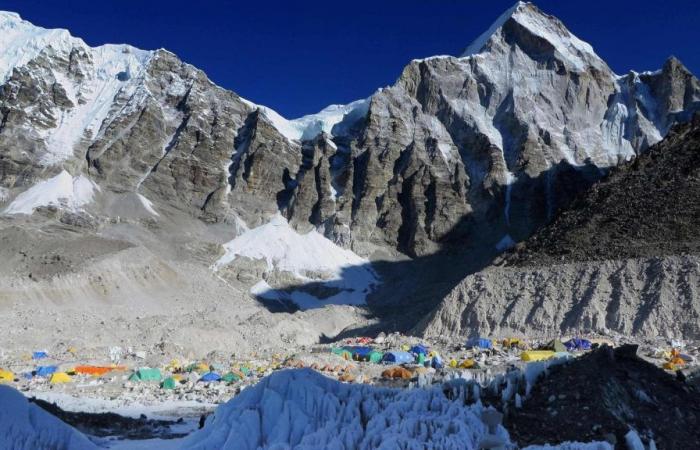
On the slopes of Everest, climate change is melting layers of snow and ice, with a macabre effect that, if possible, adds tragedy to what the Himalayan mountains experience simultaneously with the rest of the planet, albeit at an even faster pace. The thinning of the perennial mantle reveals the corpses of many of the hundreds of climbers who have died trying to reach the roof of the world.
Among the people who this year climb or will climb the highest peak on Earth there is in fact a team whose objective is not to conquer it, nor even just to clean it of waste left in increasing quality by recent mountaineering expeditions, but to bring the forgotten remains back to the valley.
At the risk of their lives, these local climbers have already recovered five frozen bodies, including one in skeletal form, which were then taken to the Nepalese capital, Kathmandu. Two have been pre-identified pending “detailed examinations” to confirm their identities, according to Rakesh Gurung, spokesman for Nepal’s tourism ministry. Those who cannot be identified will likely be cremated.
The campaign also on Lhotse and Nuptse
The campaign underway on Everest and the nearby peaks of Lhotse and Nuptse is a difficult and dangerous, as well as macabre, campaign. “Due to the effects of global warming, bodies and waste are becoming more and more visible as snow cover decreases,” says Aditya Karki, a major in the Nepalese army leading a team of 12 soldiers and 18 climbers.
More than 300 people have died on the summit since expeditions began in the 1920s, including eight in the last season alone. Many bodies remain, some hidden by snow or in deep crevasses. Others, still wearing their colorful climbing gear, have become landmarks on the way to the summit for climbers, with nicknames like “Green Boots” or “Sleeping Beauty.” “There is a psychological effect,” explains the Nepalese officer. “People believe they are entering divine territory when they climb mountains, but if they see dead bodies along the way, this can have a negative effect.”
Everest, the order of the Supreme Court of Nepal: “Limit the number of permits”. Last year the record of almost 500 “yes”: to go up you just need to pay 11 thousand dollars
03 May 2024
The critical zone, at 7,600 meters and above
Many bodies are found in the “death zone”, the one above altitude 7,600, where low oxygen levels increase the risk of “acute mountain sickness”, which can be fatal after a certain period of time. It took 11 hours to free one of the bodies, which was immersed in ice up to the torso, and hot water was used to free it and extract it with an axe. “It’s extremely difficult,” insists Tshiring Jangbu Sherpa, who led the expedition to recover the body. “Pulling the body out is one thing, taking it down is another.” According to the guide, some of the bodies are still almost as they were when they died, dressed in full gear, with crampons and harnesses. One, intact, lost only a glove.
Everest. Sherpa Kami Rita’s record: he climbs the summit for the 30th time. The penultimate one just 10 days ago
May 22, 2024
The recovery of bodies at high altitude remains a controversial topic in the mountaineering community itself. It’s an undertaking that costs thousands of dollars and requires up to eight rescuers for each body. At high altitudes it is difficult to carry heavy loads and a corpse can weigh more than 100 kilos. For Aditya Karki, however, this effort is necessary. We need to bring back as many as possible,” he says. “We keep leaving them there and our mountains will turn into cemeteries.”
During missions, bodies are often wrapped in a sack and taken down by sled. A body found near the top of Lhotse, the world’s fourth-highest mountain at 8,516 metres, was one of the most difficult to bring down, says Tshiring Jangbu Sherpa. “The body was frozen, with the hands and legs spread apart.” “We had to transport him as he was to Camp 3, and only then could he be transferred to a sled.”
The secret that could change the history of mountaineering
The Himalayas still hide many secrets. One in particular could rewrite, at least in part, the history of world mountaineering. The body of George Mallory, a British mountaineer who disappeared in 1924, was finally found in 1999, while neither that of his climbing partner, Andrew Irvine, nor their camera, which could provide proof that the two , or maybe one of them, were the first to reach the roof of the world.
The overall cleanup campaign, with a budget of more than $600,000, mobilized 171 Nepalese guides and porters to bring back 11 tons of waste. Fluorescent tents, discarded climbing gear, empty gas cylinders and even human excrement litter the route to the summit. Shipments are now obliged to dispose of the waste they produce. “This year’s waste should be brought back to the valley by climbers,” says Karki. “But who will take the old waste back down?





